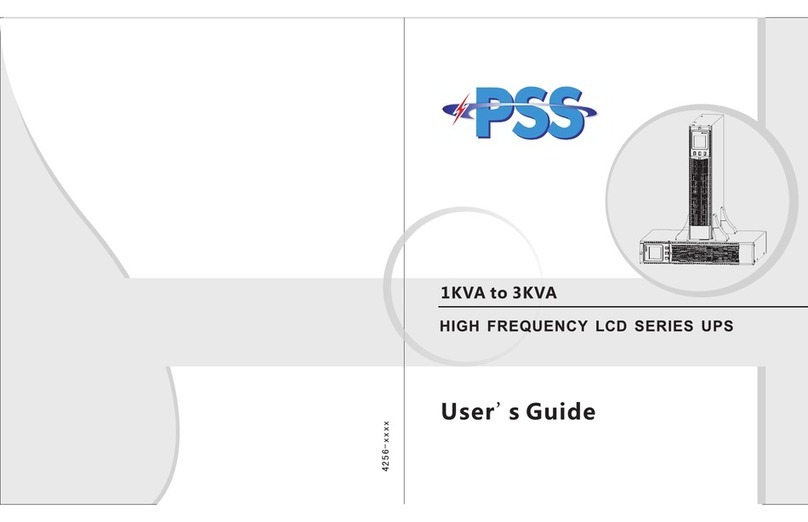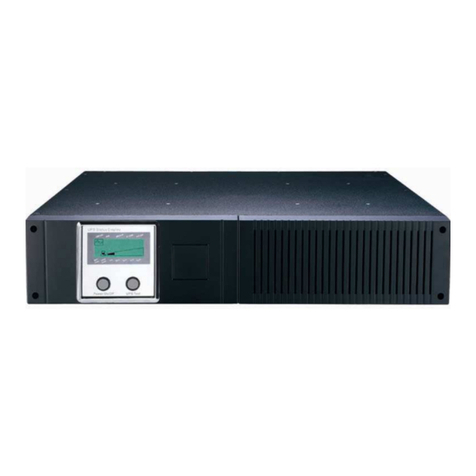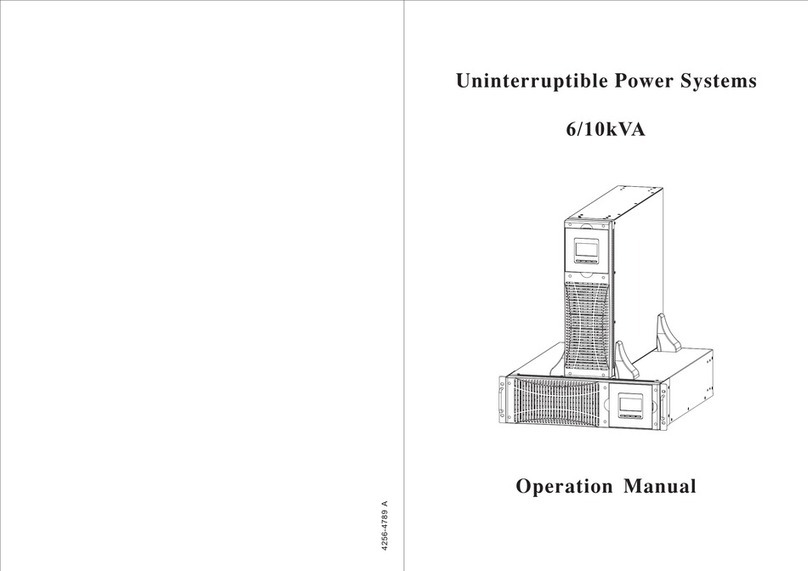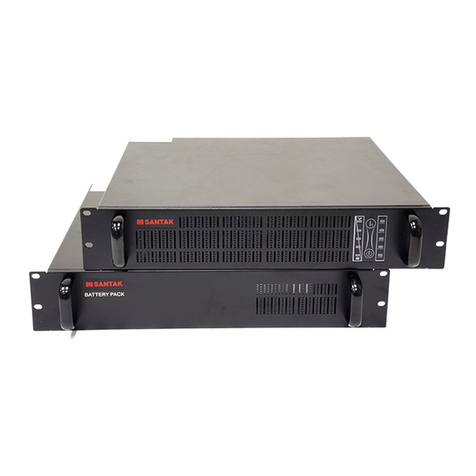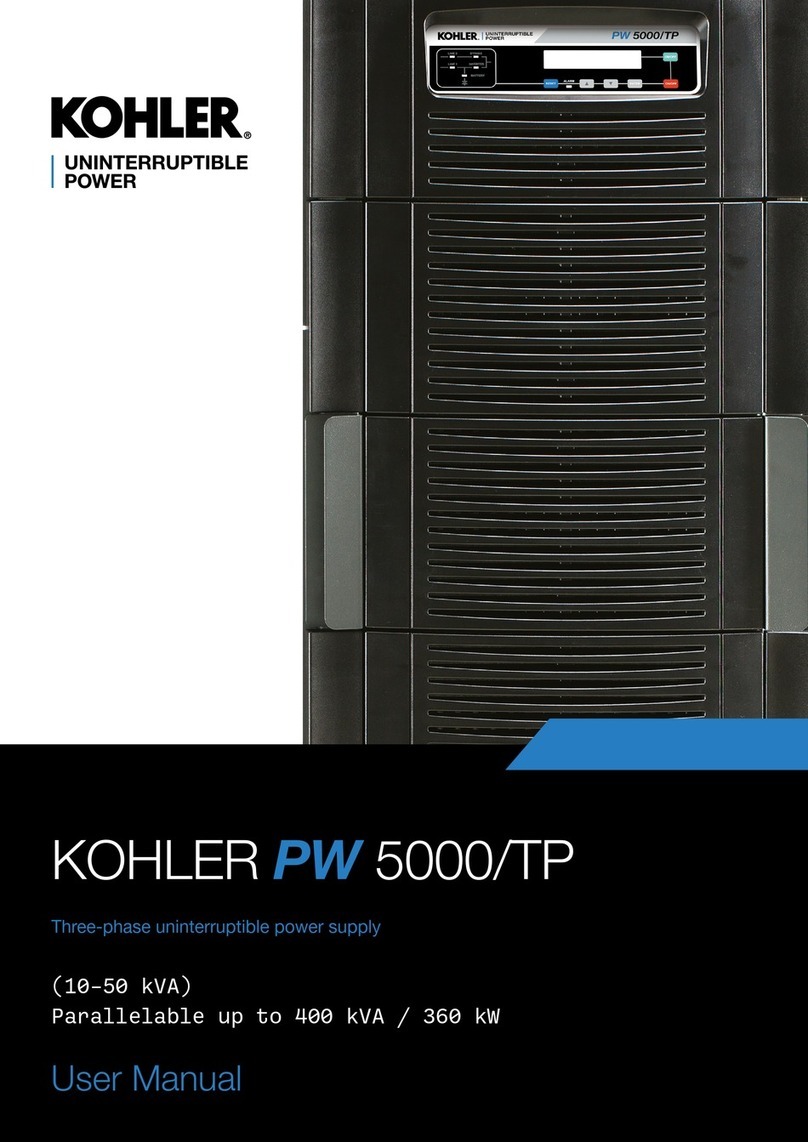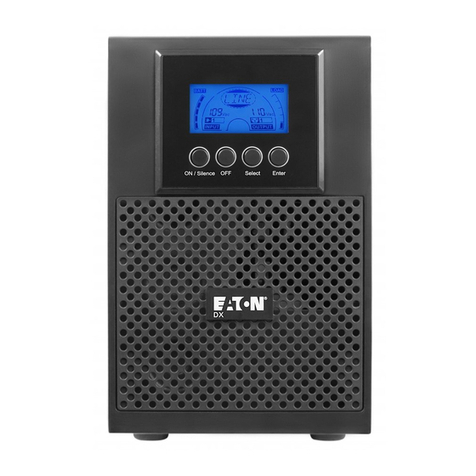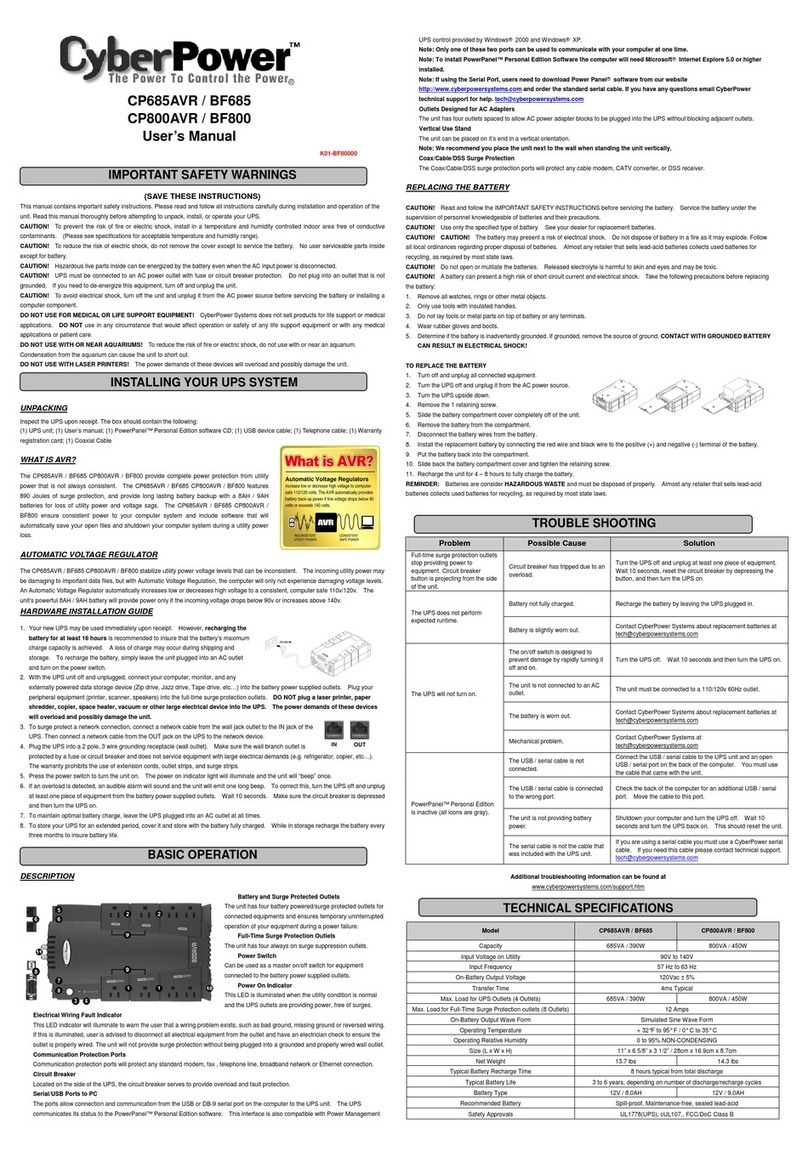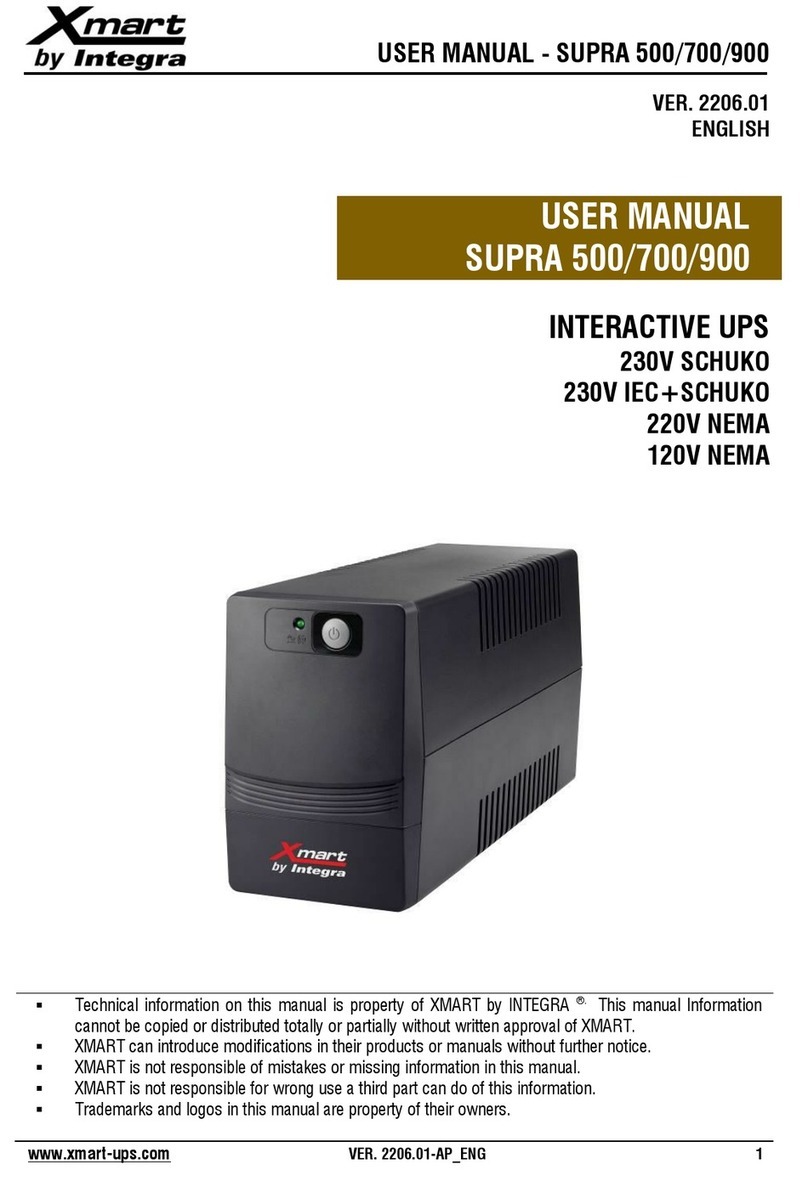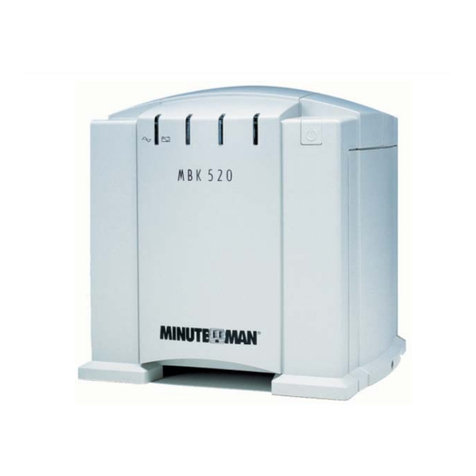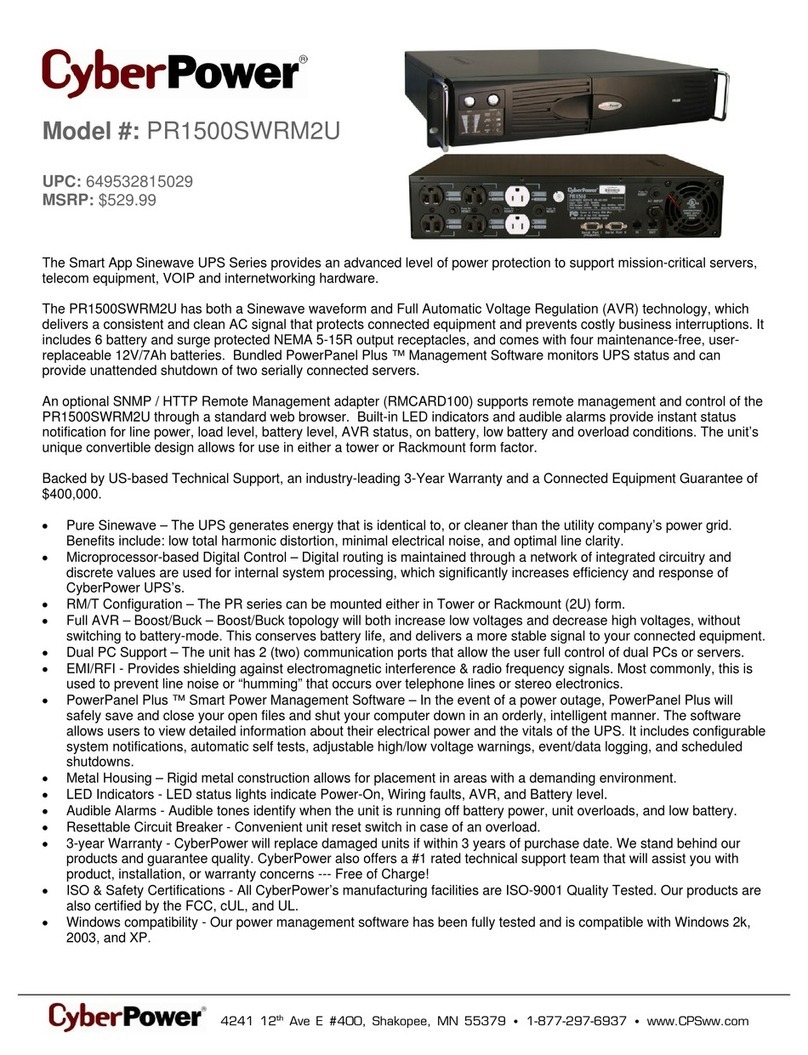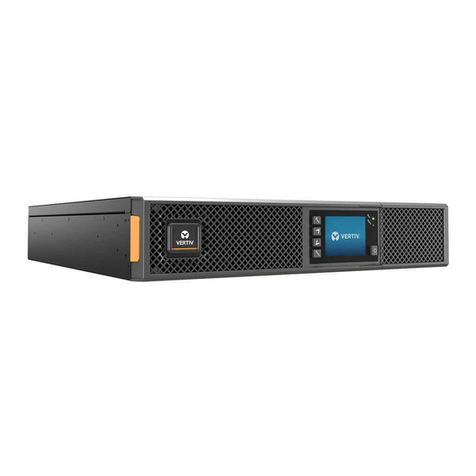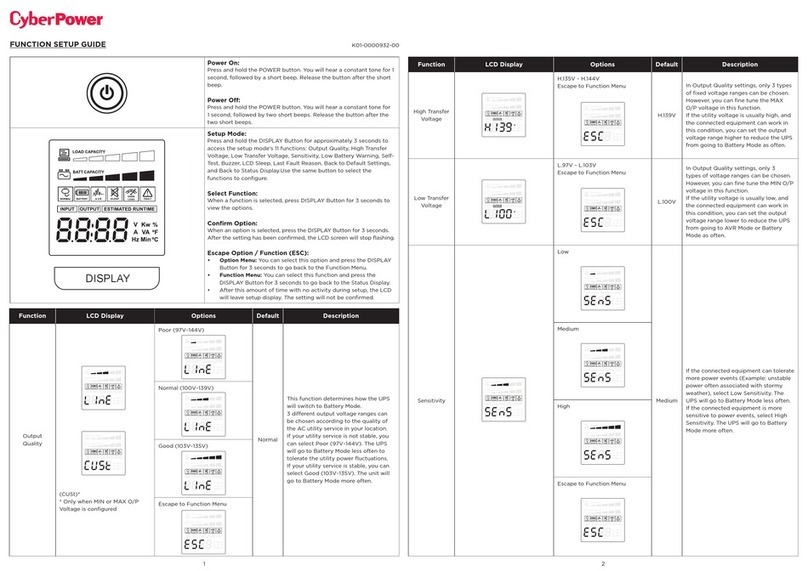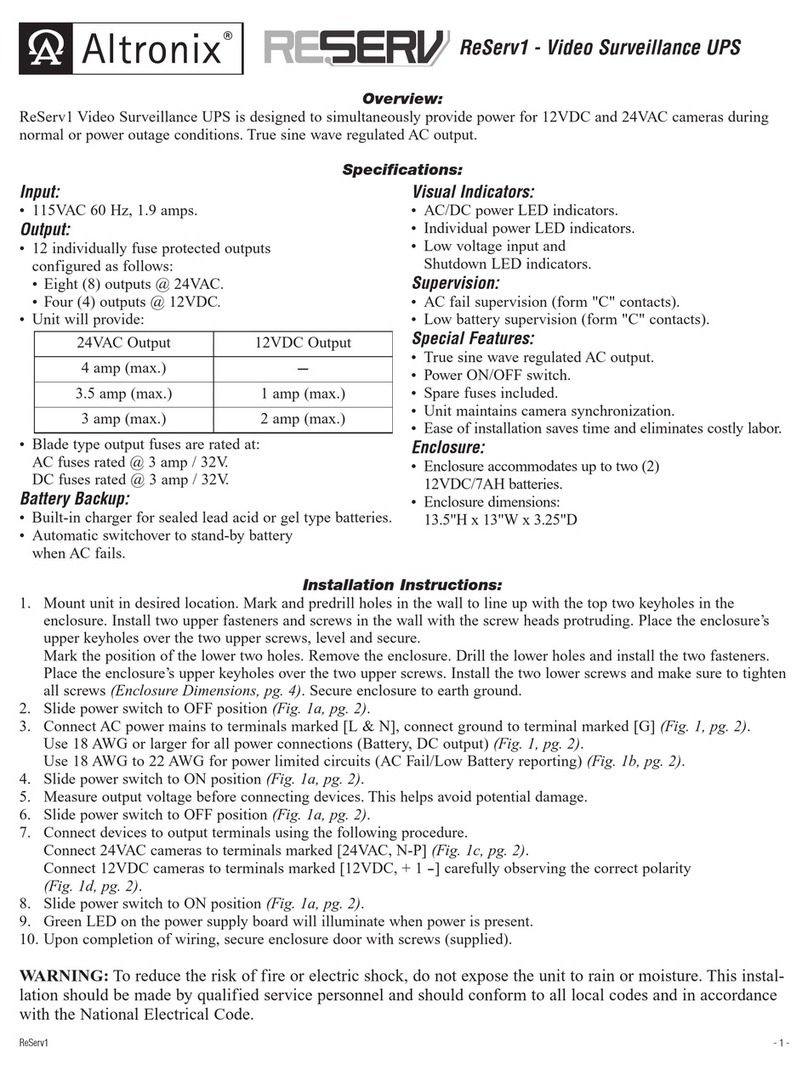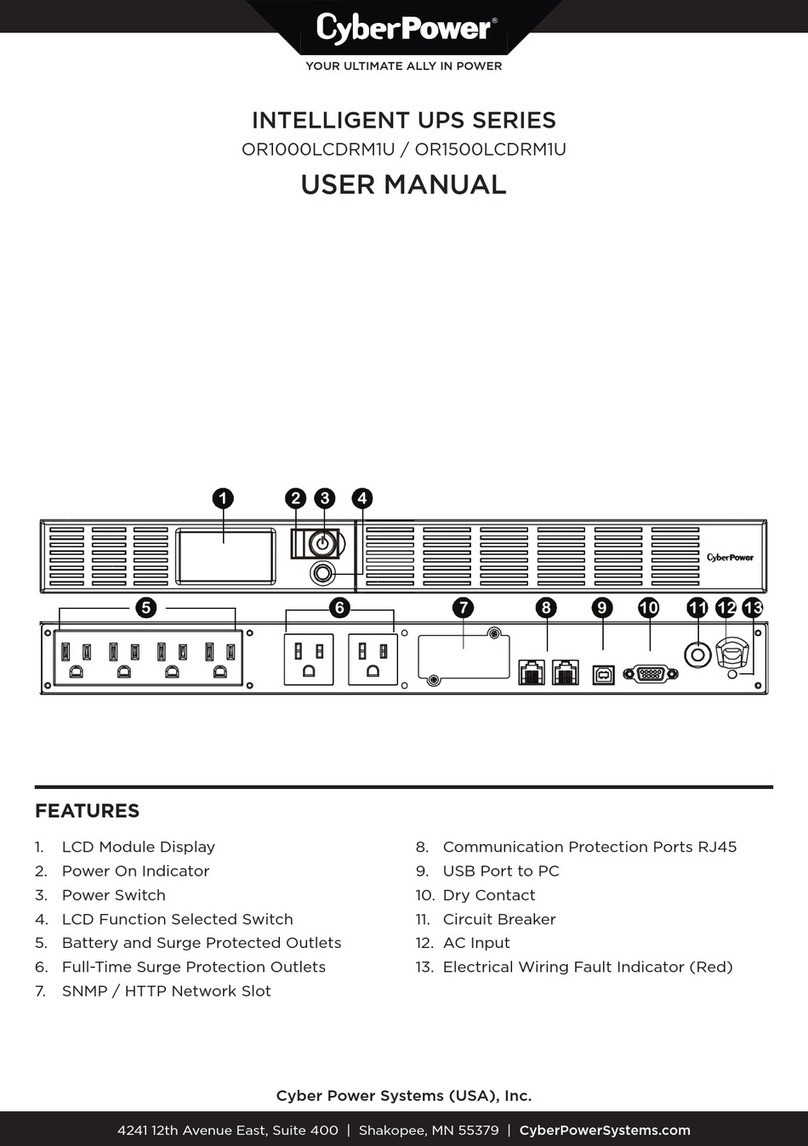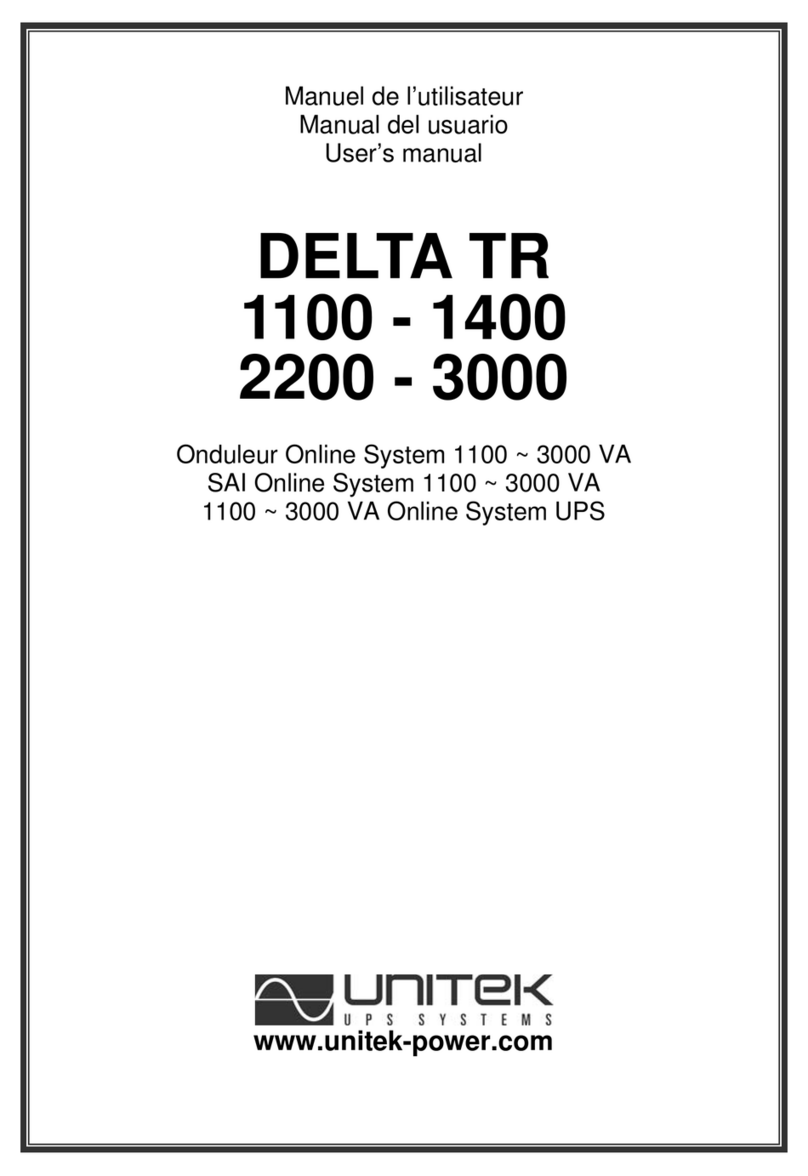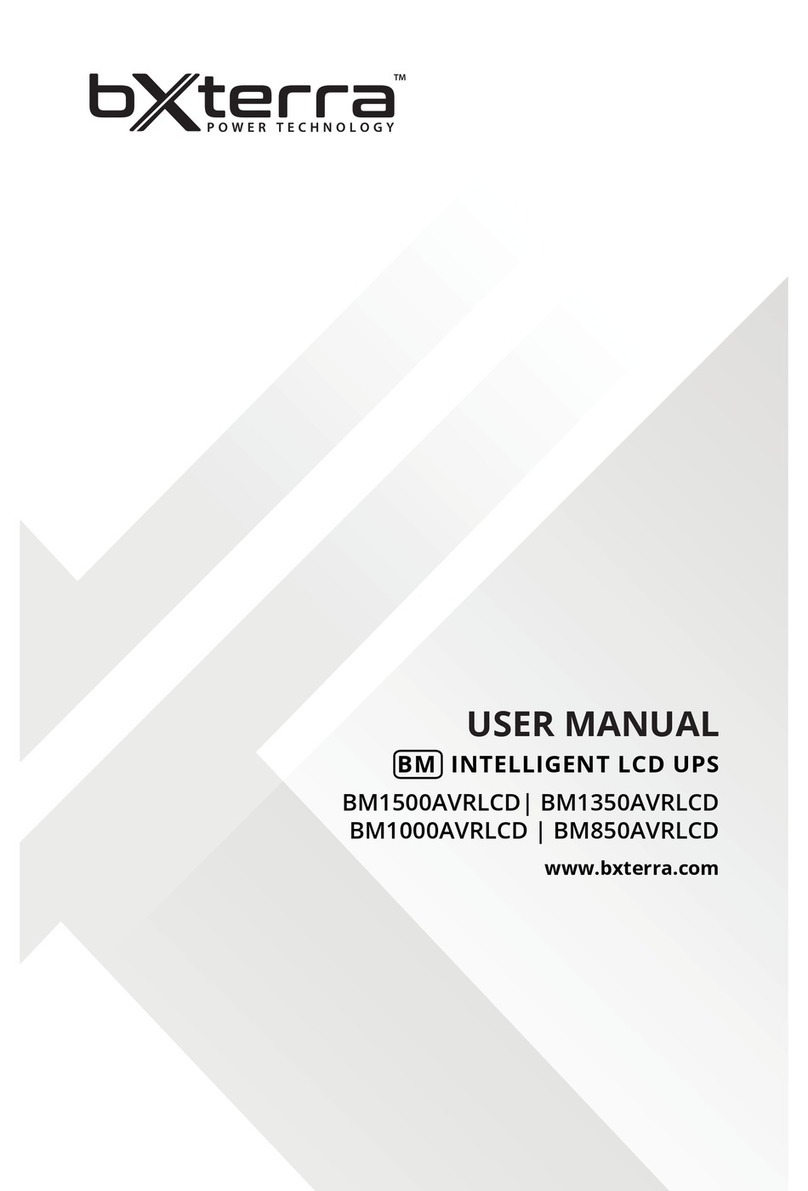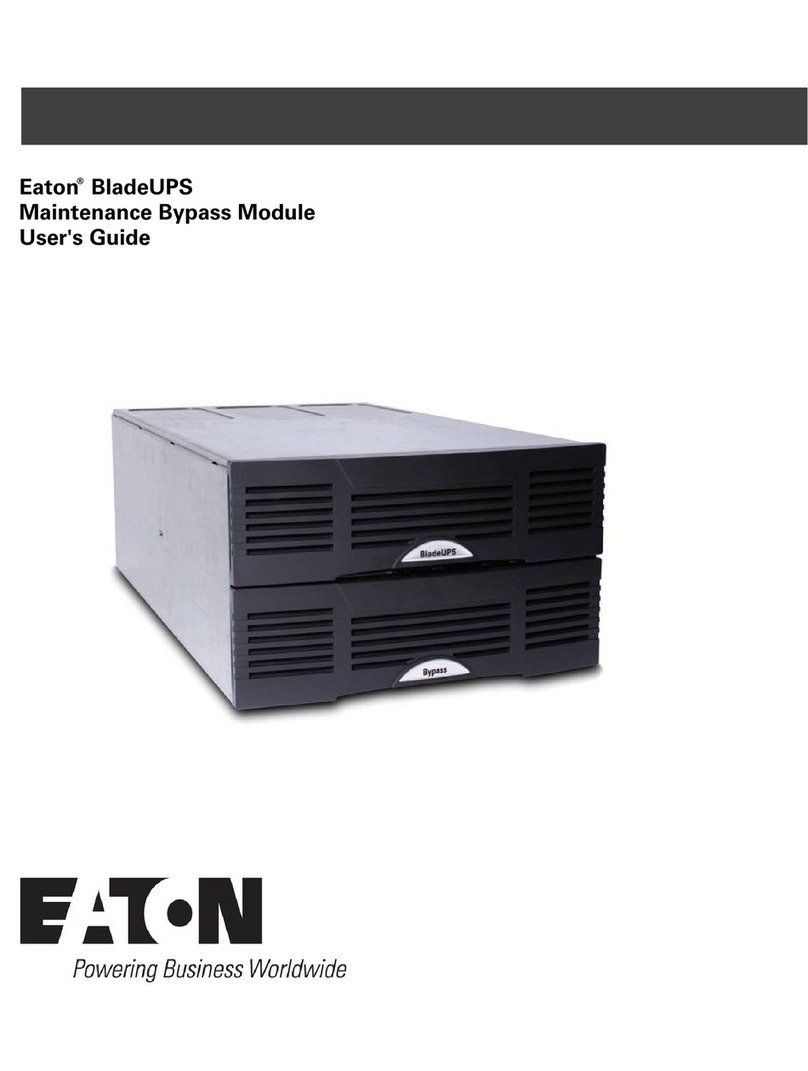PSS ECO-220 User manual

℡
UPS
Emergency Backup Power Supply
For Use With Computer Loads Only
Intelligent Auto-Shutdown Software
Power Surge/Noise Protection
Internet Line Protection Cost Efficiency
AVR Protection Compact & Reliable Design
U
US
SE
ER
R'
'S
S
M
MA
AN
NU
UA
AL
L
-
-
co
1st Edition
Uninterruptible Power System

NOTES
IMPORTANT SAFETY INSTRUCTIONS
Thank you for selecting this uninterruptible power system (UPS). It
will
provide you with better protection for connected equipment.
Please read this manual!
!!
!
This manual provides safety, installation and operating instructions that
will
help you derive the best
performance and service life that the UPS has to
offer.
Please save this manual!
!!
!
It includes important instructions for the safe use of this UPS and
for
obtaining factory service should the proper operation of the UPS come into
question.
Please save or recycle the packaging materials!
!!
!
The UPS`s shipping materials were designed
with great care to provide
protection from transportation related damage. Thes
e materials are
invaluable if you ever have to return the UPS for service. Damage sustained
during transit is not covered under the warranty.

TROUBLE SHOOTING
If the UPS failed to operate properly, please review the following checks first
.
If the problem remains, please consult sales agent for service.
Is the Master power switched on?
Is the UPS plugged into a correctly working outlet?
Is the line voltage within the rating specified?
Is the fuse on the rear panel blown?
Is the UPS over loaded?
Is battery not fully charged? Dead battery? Charger failure?
Please provide the following information when calling for service.
1. Model number, serial number.
2. Date of the problem occurred, date of purchase.
3. Full description of the problem including load, LCD, and
alarm status,
installation condition, working environment, etc.
TROUBLE SHOOTING CHART
Problem Possible Cause
Action To Take
Front panel switch
in off position. Turn on switch.
Rear panel fuse
burnt out. Replace fuse restart UPS.
No light, and no
alarm (UPS not on)
Power cord lose Check input power.
Power cord lose Check input power.No “Line-on LCD”
light, and alarm
beeps every few
seconds.
AC Fuse burnout.
Replace fuse, if problem
remains, call for service.
Backup time is less
than the rating.
Battery is not fully
charged due to
previous power
failure.
Recharge the battery for at
least 6 hours, re-test the
backup time. If problem
remains, call for service.
- 12 -
CAUTION
The UPS contains voltages
that are potentially hazardous. All repairs
should be performed by qualified service personal.
The UPS has its own internal energy source (battery). The output
receptacles may be live even when the UPS is not connected to an AC
supply.
The UPS is suitable for computers and electronic equipment. And
not
suitable for electronic equipment with significant inductive loads, such
as motors & fluorescent lamps.
Be sure to operate within the power rating of the UPS. Below 1/2 or 1/3
of rated power is recommended for longer backup time & longer battery
life.
Do not place the UPS near excessive humidity, in direct sunlight
, or
close to heat-emitting sources.
If the UPS is out of order, please detach power cord and consult your
dealer right away. Do not remove cover if there is no serviceable part
inside.
The unit should be supplied by a
grounded source. Do not operate the
unit without ground source.
The socket-
outlet should be installed near the equipment and be easily
accessible.
Do not plug the UPS power cord into itself. That will result in a safety
hazard.
Installation should be performed by a qualified technician or electrician
in accordance with local electrical codes.
- 1 -

BATTERY FACTS
The battery is the only periodically serviceable parts in the UPS. An
expected life is approx. 3∼5 years. H
owever, frequent long discharges or
ambient temperatures above 80°F/26°C
will shorten battery life. Therefore, it
is recommended to replace the batteries every 3 years after initiating the
unit.
Recharge batteries every 3 months if it is not in use becaus
e it may cause
batteries over-drain.
WARNING
Only a qualified technician should replace the battery. Batteries have
high short-
circuit current capacity; mistakes in connecting or
disconnecting can cause connections to arc or weld and could cause
severe burns.
STORAGE
The UPS should only be stored if the battery is fully charged. Avoid storage
temperatures above 80°F/26°C
as battery life is significantly shortened.
Every 90 days remove the unit from storage and plug it in for 24 hours to
recharge the batte
ries. Batteries may be damaged if left in storage and not
recharged every 90 days.
IMPORTANT NOTICE
Please use same type and same rating of batteries for replacement.
Do not replace it with the battery that exceeds specified rating.
- 10 -
SYSTEM CONCEPT
The purpose of this chapter is to give you a better understanding about how
a UPS works..
1. Block Diagram
AVR.
INV.
CHA.
N.F. N.F.
INPUT
OUTPUT
Fig. 1 shows how UPS works.
2. Normal Operation
There are two main loops whenAC Utility normal the AC ou
tput loop and the
battery charging loop. The AC output gets power from AC utility input and
pass through AVR to support power to load. In the same time, the AC utility
input is converted by AC/DC CHA and support charging power to charge
batteries.
AVR.
INV.
CHA.
N.F. N.F.
INPUT
OUTPUT
Fig. 2 shows how the UPS works whenAC Utility normal.
- 3 -

INSTALLATION AND OPERATION
Upon receipt of the UPS, inspect the shipping carton for damage. If there is
any obvious damage, immediately report it to the selling dealer
or the
delivering carrier. If there is no damage to the shipping carton, unpack the
unit and inspect the unit for damage.
The UPS is designed for installation in a protected environment within a
temperature range from 32°F/0°C to 104°F/40°C and relative h
umidity of
0∼
90% without condensation. Do not block inlets and outlets. Install the
system in a location free from excessive dust and chemical fumes.
Check the identification label to verify the UPS voltage and power rating
match the available line voltage and load requirements.
Installation:
1.
Check if the main switch on the UPS front panel is in the off position and
insure that the voltage of the AC utility source corresponds to the
nameplate on the UPS rear panel.
2. Plug the power cable into the grounded socket. If indicators of LINE-
ON
& CUT-
OFF LCD light on, it mean AC power is normal, although UPS is
under CUT-OFF status, it still will automatically start to charge by itself.
3. Push the main switch, then the Load Level LCD will light up
for 2
seconds and CUT-OFF LCD will go off. The UPS will then be
ready
and start to work normally.
4. Connect your PC with UPS, and then
turn on PC. Be sure to check the
Load Level LCD indicator and DO NOT OVERLOAD it over 100%. To
simulate AC failure (Push UPS test switch) c
an help to insure whether
UPS is in good condition or not. It is designed to sound an
alarm every 3
seconds and with BACK-UP LCD light on when simulation starts.
If the
CUT-
OFF LCD is on, it means UPS fault or BATTERY fault. Then you
have to contact your local service center
5.
When battery approaches low level, alarm will beep every second until
auto shut down
6. The 4 conditions UPS will automatically shut down:
a. Battery low b. Short circuit
c. Overload d. UPS fault
- 8 -
OVERVIEW
Front Panel
1. UPS Test Switch:
When UPS is working under AC mode, it also
activates the UPS`s self-test by press the bottom.
2. Master Power Switch: Turn on/off the UPS.
3. LINE-ON: AC Normal.
4. AVR Protection LCD:
When AVR is working under protection mode,
the light will turn on.
5. BACK-UP: Battery in back-up
6. Over Load:
If the UPS is overloaded, the light will turn on and the alarm
will sound continuously.
7. UPS Cut-off: Overload or Cut-off
8. Battery Level:
A bar graph showing how much of the UPS battery is
being used.
9. Load Level: A b
ar graph showing how much of the UPS power is being
used.
Rear Panel
1. AC line input socket: Connect power cable from the UPS to AC utility.
2. AC input fuse:
Contain the fuse to protect the UPS from over current
from incoming AC utility.
3. Output receptacles:
Connect power cables of computer equipment to
these sockets.
4. Computer interface:
This socket combines relay contact signals and
RS-232 signals (Option) on DB9 connector.
5. Phone/Fax/Modem jack:
Telecom transfer ports provide users to
extend the applications.
6. EXT. Battery:
Connect external battery cable for battery bank to the
UPS.
7. UPS setup switch:
Dip1.Low load (below 50w) auto-shut OFF.
Low load auto-shut ON.
Dip2.DC-start ON.
DC-start OFF.
Dip3.Buzzer auto-reset OFF.
Buzzer auto-reset ON.
- 5 -

CONTENTS
PAGE
1. CAUTION…………………………………………………………..…..1
2. INTRODUCTION
SYSTEM DESCRIPTION………………………….……………..2
FEATURES………………………………….……………………..2
3. SYSTEM CONCEPT
BLOCK DIAGRAM……………………………….………………..3
NORMAL OPERATION………………………….………………..3
AC UTILITY FAILURE………………………….…………………4
4. OVERVIEW
FRONT PANEL……………………………………………………5
REAL PANEL………………………………………………………5
PICTURE…………………………………………………….…….6
5. INSTALLATION AND OPERATION…………………………………8
6. COMPUTER INTERFACE……..…………………………………….9
7. BATTERY FACTS……………………………………………………10
8. SPECIFICATIONS……………………………………………………11
9. TROUBLE SHOOTING………………………………...……………12
10.EXT. BATTERY…………..……………………….……………….…13
EXT. BATTERY
Operation process for
UPS being fitted with additional Battery Bank for
extending back-up time:
1. Connect AC Main Power under UPS machine in no load condition.
2.
To make sure Battery group voltages are same as DC BUS voltages of
UPS machine.
3. Connect two devices between UPS machine and Battery Bank.
4.
Push UPS test button to check UPS machine is working
normal to switch to Battery Back-up mode.
*
Above UPS operation process must be ensured turn onAC Main Power
firstly, then connect Battery Bank, In order to avoid spark when
connect
cable wire between UPS machine and Battery Bank.
- 13 -

INTRODUCTION
System Description
The product is a line interactive UPS with the latest technology and many
powerful functions. The UPS has an AVR function which allows a input
voltage range from 75% to 125%, including a on line voltage boost-up &
buck down. Ideal protection equipment for critical connected loads.
In addition, This UPS provides advanced single telephone line or modem
surge suppression through the modular connectors on the back panel.
The Line Interactive UPS and monitoring software (Optional kits) makes our
computer operate intelligently and provides you with the ability of perfect
protection of your critical devices.
Features
Microprocessor design for true RS-232 (Option).
Line interactive design.
User-friendly LCD display.
Provide boost and buck AVR to stabilize input voltage.
Provides lightning, surge, overload, and short-circuit protection.
Built-in CCCV battery charger and battery over drain protection.
No load auto shutdown (Dip switch setup).
Load level and Battery level display.
Buzzer alarm auto-reset (Dip switch setup).
Auto restart when AC recovery.
Cold start function (Dip switch setup).
Tel / Modem / Fax / Internet surge suppression.
Option Bundle software:Automatically save your valuable files before
auto shutdown. - 2 -
SPECIFICATIONS
Model
ECO-220
ECO-300
Capacity VA 2200VA
3000VA
Voltage
110VAC, 115VAC, 120VAC, 220VAC, 230VAC or 240VAC
±25%
Input
Frequency 50Hz or 60Hz ±5%
Voltage (Batt. Mode) 110VAC, 115VAC, 120VAC, 220VAC, 230VAC or 240VAC
±5%,
Frequency 50Hz or 60Hz ±1Hz
Waveform Modified sine wave
Output
Transfer Time Less than 4ms (typical)
Battery Type HR 1221W *4PCS
Battery Recharge Time 5 hours to 90% of full capacity
Indicator LCD LCD indicator for line on, battery back-
up, AVR protection,
Overload and cut-off, Load and battery level
Battery Back-up Sounding every 3 seconds
Battery Low Sounding every 1 second
Alarm
Overload Continue beeping sound
Overload Fuse & current limited
Short Circuit Fuse & current limited & cut-off
Protection
Batt. Low Cut-off No battery drain after cut-off
Physical Dimension, D*W*H 408*143*197 mm
Operating Temperature
32°F/0°C-104℉/40°C at full load, 0~90% relative
humidity
(non-condensing)
Environment
Noise Level Less than 40db (at 1 meter)
Contact Closure DB9 connector for connecting with iMate software
Interface Smart RS-232 True RS-232 with iMate Pro software (Option)

- 11 -

3. AC Utility Failure
If AC utility fails, the UPS quickly detects the problem and activates the
inverter. The inverter. The DC/AC inverter changes DC power from the
batteries intoAC and provides continuous uninterruptible power to load.
AVR.
INV.
CHA.
N.F. N.F.
INPUT
OUTPUT
Fig. 3 shows how the UPS works whenAC Utility Failure
- 4 -
COMPUTER INTERFACE
The computer interface (DB9 port) on the back of the UPS may be
connected to a host computer. This port allows the computer to monitor the
status of the UPS and control the operation of the UPS. The UPSilon-
2000
((option),M2502 Cable), provides complete On-
Screen power management
to the UPS and computer systems. Its major functions normally include
some or all the following:
Real-time UPS status on screen.
All history records in memory.
Auto orderly shutdown for computer & UPS.
Multi-server support.
Auto file save even without filename preset.
Scheduled switch on/off daily or weekly.
Pin out information:
PIN# Description I/O
Input
Output
Output
PIN1
PIN2
PIN3
PIN4
PIN5
PIN6
RS232 DTR, must keep in high state
Line fail, normally open, active close
N.C.
Common for PIN 2,5
Battery low, normally open, active close
Two purposes on this pin
(1)Remote shut down, keep this pin high
(+5~+12V) for 3S will turn off the UPS
(2)RS232 Receiver Rx
Input
PIN7 Ground for PIN 6,9
PIN8 N.C.
PIN9 RS232 Transmitter TX Output
12345
6
7
89
D-SUB 9 Pin Female Connector
Signal High Min. 3 Second
Contacts
Normally
Open
Low Battery
Mains Failure
Common
or RS232 RX
RS232 DTR
RS232 TX
Pin Number
UPS Shut Down
1
2
3
4
5
6
7
8
9
- 9 -

Picture:
Front Panel:
1
2
-
-
3
4
5
6
7
8 9
0% 25%50%75%100%
co
- 6 -
Rear Panel:
IEC-320:
ACINPUT
INOUT
INTERNET
REMOTE
ACFUSE
1 2 3
Dc-start ON
Noloadauto-shutdownON
Buzzer auto-reset ON
CAUTION:
RISK OF ELECTRIC SHOCK.
DO NOT REMOVE COVER
5
1
3
7
AC/BATTERYOUTPUTS
2200VA
2
4
- 7 -
This manual suits for next models
1
Table of contents
Other PSS UPS manuals
